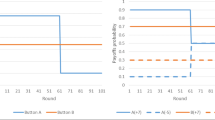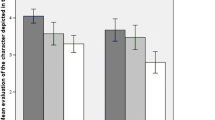Abstract
Participants in three studies were asked to estimate the percentage of times they exhibited polar ends of a trait dimension (e.g., behaved cooperatively or uncooperatively) when the opportunity to display that trait arose, and then to evaluate their standing on the trait based on their behavioral estimates. Approximately 6 weeks later, participants were provided with behavior estimates that purportedly represented the average estimates of their peers and asked to evaluate the average person's standing on the trait dimension. The “better than myself effect” is reflected in the finding that people consistently evaluate themselves more favorably than others, even when the behavioral estimates on which they base their ratings of the average person are the identical estimates they provided for themselves. Study 1 demonstrated the basic “better than myself effect,” and Study 2 showed that participants did not alter their behavior estimates when they learned that the average person's estimates were the same as their own. Study 3 demonstrated the “better than myself” effect in comparisons with a randomly selected peer rather than the average peer. A fourth study, using a different methodology, showed that people who wrote behavior descriptions to represent their standing on a trait dimension, and then read similar trait descriptions from a randomly selected peer, also continued to evaluate themselves more favorably than others, despite basing these evaluations on behavior descriptions that were presumably no more favorable than those provided by others.
Similar content being viewed by others
REFERENCES
Alicke, M. D. (1985). Global self-evaluation as determined by the desirability and controllability of trait adjectives. Journal of Personality and Social Psychology, 49, 1621-1630.
Alicke, M. D., Klotz, M. L., Breitenbecher, D. L., Yurak, T. J., & Vredenburg, D. S. (1995). Personal contact, individuation, and the better-than-average effect. Journal of Personality and Social Psychology, 68, 804-825.
Allison, S. T., Messick, D. M., & Goethals, G. R. (1989). On being better but not smarter than others: The Muhammad Ali effect. Social Cognition, 7, 275-296.
Bem, D. J. (1967). Self-perception: An alternative interpretation of cognitive dissonance phenomena. Psychological Review, 74, 183-200.
Bem, D. J. (1972). Self-perception theory. In L. Berkowitz (Ed.), Advances in experimental social psychology (Vol. 6, pp. 1-62). New York: Academic Press.
Buss, D. M., & Craik, K. H. (1983). The act frequency approach to personality. Psychological Review, 90, 105-126.
Dunning, D., Meyerowitz, J. A., & Holzberg, A. D. (1989). Ambiguity and self-evaluation: The role of idiosyncratic trait definitions in self-serving assessments of ability. Journal of Personality and Social Psychology, 57, 1082-1090.
Festinger, L. (1954). A theory of social comparison processes. Human Relations, 7, 117-140.
Greenwald, A. G. (1980). The totalitarian ego: Fabrication and revision of personal history. American Psychologist, 35, 603-618.
James, W. J. (1890). Principles of psychology. New York: Holt.
Kihlstrom, J. F., & Cantor,N. (1984). Mental representations of the self. In L. Berkowitz (Ed.), Advances in experimental social psychology (Vol. 17, pp. 2-48). New York: Academic Press.
Klar, Y., & Giladi, E. E. (1997). No one in my group can be below the group's average: A robust positivity bias in favor of anonymous peers. Journal of Personality and Social Psychology.
Klein, S. B., & Loftus, J. (1993). The mental representation of trait and autobiographical knowledge about the self. In T. K. Srull & R. S. Wyer (Eds.), Advances in social cognition (Vol. 5, pp. 1-49). Hillsdale, NJ: Erlbaum.
Klein, S. B., Loftus, J., & Burton, H. A. (1989). Two self-reference effects: The importance of distinguishing between self-descriptiveness judgments and autobiographical retrieval in self-referent encoding. Journal of Personality and Social Psychology, 56, 853-865.
Klein, S. B., Loftus, J., & Sherman, J. W. (1993). Trait judgments about the self: Evidence from the encoding specificity paradigm. Personality and Social Psychology Bulletin, 18, 730-735.
Klein, S. B., Loftus, J., Trafton, J. G., & Fuhrman, R.W. (1992). Use of exemplars and abstractions in trait judgments: A model of trait knowledge about the self and others. Journal of Personality and Social Psychology, 63, 739-753.
Klein, W. M. (1966). Maintaining self-serving social comparisons: Attenuating the perceived signifi-cance of risk-increasing behaviors. Journal of Social and Clinical Psychology, 15, 120-142.
Klein, W. M., & Kunda, Z. (1993). Maintaining self-serving social comparisons: Biased reconstruction of one's past behaviors. Personality and Social Psychology Bulletin, 19, 732-739.
Perloff, L. S., & Fetzer, B.K. (1986). Self-other judgments and perceived vulnerability to victimization. Journal of Personality and Social Psychology, 50, 502-510.
Schlenker, B. R. (1980). Impression management: The self-concept, social identity, and interpersonal relations. Monterey, CA: Brooks/Cole.
Schlenker, B. R. (1982). Translating actions into attitudes: An identity-analytic approach to the explanation of social conduct. In L. Berkowitz (Ed.), Advances in experimental social psychology (Vol. 15, pp. 193-247). New York: Academic Press.
Suls, J., & Wheeler, L. (in press). Handbook of social comparison. New York: Kluwer Academic.
Tabachnik, N., Crocker, J., & Alloy, L. B. (1983). Depression, social comparison, and the falseconsensus effect. Journal of Personality and Social Psychology, 45, 688-699.
Taylor, S. E., & Brown, J. D. (1988). Illusion and well-being: A social psychological perspective on mental health. Psychological Bulletin, 103, 193-210.
Taylor, S. E., & Brown, J. D. (1994). Positive illusions and well-being revisited: Separating fact from fiction. Psychological Bulletin, 116, 21-27.
Tesser,A. (1988).Toward a self-evaluation maintenance model of social behavior. InL. Berkowitz (Ed.), Advances in experimental social psychology (Vol. 21, pp. 181-227). New York: Academic Press.
Weinstein, N. D. (1980). Unrealistic optimism about future life events. Journal of Personality and Social Psychology, 39, 806-820.
Weinstein, N. D. (1983). Reducing unrealistic optimism about illness susceptibility. Health Psychology, 2, 11-20.
Weinstein, N. D. (1984). Why it won't happen to me: Perceptions of risk factors and susceptibility. Health Psychology, 3, 431-457.
Weinstein, N. D., & Lachendro, E. (1982). Egocentrism as a source of unrealistic optimism. Personality and Social Psychology Bulletin, 8, 195-200.
Author information
Authors and Affiliations
Rights and permissions
About this article
Cite this article
Alicke, M.D., Vredenburg, D.S., Hiatt, M. et al. The “Better Than Myself Effect”. Motivation and Emotion 25, 7–22 (2001). https://doi.org/10.1023/A:1010655705069
Issue Date:
DOI: https://doi.org/10.1023/A:1010655705069




